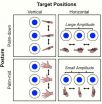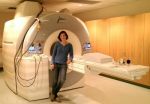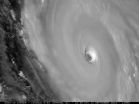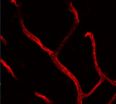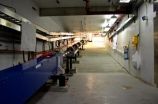(Press-News.org) Our human brains are filled with maps: visual maps of our external environments, and motor maps that define how we interact physically within those environments. Somehow these separate points of reference need to correspond with — and to — one another in order for us to act, whether it's grasping a coffee cup or hitting a tennis ball.
How that happens is the focus of a new study by scientists at UC Santa Barbara. The researchers used neuroimaging to decode how the brain transforms sensory input into action. Their findings are reported in the Journal of Neuroscience.
A doctoral student in UCSB's new Interdepartmental Graduate Program in Dynamical Neuroscience, lead author Deborah Barany and colleagues measured brain activity as participants made wrist movements in different directions (left and right, or up and down) in one of two postures while in an MRI scanner.
"Trying to record the movements performed in the scanner was the first major challenge of the experiment," Barany said. To accomplish this, she implemented a sophisticated setup in which cameras recorded LED lights placed on the right hand to track very fine movements during brain scanning. "We were ultimately able to gather a rich set of movement data to relate to brain activity."
The researchers used an analysis technique that allowed them to parse out the specific patterns of brain activity corresponding to different aspects of movement. Building on previous research, they found brain areas containing maps for the spatial location where a movement was to go as well as the actual movement direction. One of these areas, the superior parietal lobule, contained information for both location and direction, suggesting that this area helps facilitate the transformation process.
An unexpected finding was that these movement-related maps were highly sensitive to the posture of the hand. "It was surprising to see representations of posture throughout the motor system," said Barany. "This may mean that posture-dependent planning is more widespread in the brain than previously thought."
"Even if you can distinguish brain activity for two actions, you still don't know if that is because of differences in where things are in the world or differences in the way the muscles are being used," said Scott Grafton, a professor in UCSB's Department of Psychological and Brain Science and director of the campus's Action Lab, where Barany is a member. "What Deborah figured out how to do is overcome that uncertainty using state-of-the-art decoding methods."
This work helps to explain the deficits of patients with neurological damage affecting the processing of visuomotor transformations. The researchers' findings may guide the development of novel therapies to treat patients with optic ataxia (an inability to accurately reach to objects) and ideomotor apraxia (a deficit in imitating gestures under command).
INFORMATION:
Deconstructing goal-oriented movement
UCSB scientists develop a new way to decode specific aspects of movement in the human brain
2014-05-14
ELSE PRESS RELEASES FROM THIS DATE:
Virtual pet leads to increase physical activity for kids, UGA research says
2014-05-14
Athens, Ga. – Placing children into a mixed reality—part virtual environment and part real world—has great potential for increasing their physical activity and decreasing their risk of obesity, according to University of Georgia researchers.
Sixty-one Georgia 4-H'ers, 9-12 years old, participated in a study designed to increase awareness and reduce childhood obesity. Participants set goals for the amount of physical activity they wanted to complete throughout the day over a course of three days. An activity monitor was worn to track their activity.
Children were split ...
Study shows tropical cyclone intensity shifting poleward
2014-05-14
MADISON, Wis. — The latitude at which tropical cyclones reach their greatest intensity is gradually shifting from the tropics toward the poles at rates of about 33 to 39 miles per decade, according to a study published today (May 14, 2014) in the journal Nature.
The new study was led by Jim Kossin, a National Oceanic and Atmospheric Administration (NOAA) National Climatic Data Center scientist stationed at the University of Wisconsin-Madison's Cooperative Institute for Meteorological Satellite Studies. The research documents a poleward migration of storm intensity in ...
NIH takes action on sex/gender in cell and animal studies
2014-05-14
What:
NIH leadership is available to answer questions from reporters about new policies that will be published online Wednesday in Nature to ensure that sex is treated as a fundamental variable in the preclinical biomedical research that it funds.
Article: NIH takes action on sex/gender in cell and animal studies. Nature. Clayton, J.A. & Collins, F.S.. Published online May 14, 2014.
Spokesperson:
Janine Austin Clayton, M.D., NIH Associate Director for Research on Women's Health, Director for the NIH Office of Research on Women's Health
INFORMATION:
Contact: To ...
Study: Dangerous storms peaking further north, south than in past
2014-05-14
Powerful, destructive tropical cyclones are now reaching their peak intensity farther from the equator and closer to the poles, according to a new study co-authored by an MIT scientist.
The results of the study, published today in the journal Nature, show that over the last 30 years, tropical cyclones — also known as hurricanes or typhoons — are moving poleward at a rate of about 33 miles per decade in the Northern Hemisphere and 38 miles per decade in the Southern Hemisphere.
"The absolute value of the latitudes at which these storms reach their maximum intensity seems ...
Possible new plan of attack for opening and closing the blood-brain barrier
2014-05-14
Like a bouncer at an exclusive nightclub, the blood-brain barrier allows only select molecules to pass from the bloodstream into the fluid that bathes the brain. Vital nutrients get in; toxins and pathogens are blocked. The barrier also ensures that waste products are filtered out of the brain and whisked away.
The blood-brain barrier helps maintain the delicate environment that allows the human brain to thrive. There's just one problem: The barrier is so discerning, it won't let medicines pass through. Researchers haven't been able to coax it to open up because they ...
Tropical cyclone 'maximum intensity' is shifting toward poles
2014-05-14
Over the past 30 years, the location where tropical cyclones reach maximum intensity has been shifting toward the poles in both the northern and southern hemispheres at a rate of about 35 miles, or one-half a degree of latitude, per decade according to a new study, The Poleward Migration of the Location of Tropical Cyclone Maximum Intensity, published tomorrow in Nature.
As tropical cyclones move into higher latitudes, some regions closer to the equator may experience reduced risk, while coastal populations and infrastructure poleward of the tropics may experience increased ...
Researchers discover how DHA omega-3 fatty acid reaches the brain
2014-05-14
It is widely believed that DHA (docosahexaenoic acid) is good for your brain, but how it is absorbed by the brain has been unknown. That is - until now. Researchers from Duke-NUS Graduate Medical School Singapore (Duke-NUS) have conducted a new study identifying that the transporter protein Mfsd2a carries DHA to the brain. Their findings have widespread implications for how DHA functions in human nutrition.
People know that DHA is an essential dietary nutrient that they can get from seafood and marine oils. Baby formula companies are especially attuned to the benefits ...
California mountains rise as groundwater depleted in state's Central Valley
2014-05-14
Winter rains and summer groundwater pumping in California's Central Valley make the Sierra Nevada and Coast Ranges sink and rise by a few millimeters each year, creating stress on the state's earthquake faults that could increase the risk of a quake.
Gradual depletion of the Central Valley aquifer because of groundwater pumping also raises these mountain ranges by a similar amount each year – about the thickness of a dime – with a cumulative rise over the past 150 years of up to 15 centimeters (6 inches), according to calculations by a team of geophysicists.
While the ...
CEBAF beam goes over the hump: Highest-energy beam ever delivered at Jefferson Lab
2014-05-14
The Continuous Electron Beam Accelerator Facility (CEBAF) at the U.S. Department of Energy's Thomas Jefferson National Accelerator Facility has achieved the final two accelerator commissioning milestones needed for approval to start experimental operations following its first major upgrade.
In the early hours of May 7, the machine delivered its highest-energy beams ever, 10.5 billion electron-volts (10.5 GeV) through the entire accelerator and up to the start of the beamline for its newest experimental complex, Hall D. Then, in the last minutes of the day on May 7, the ...
Who should be saved? Study gets diverse MD community views on healthcare disaster planning
2014-05-14
BALTIMORE—In the event of a flu pandemic, who should have priority access to life-saving ventilators, and who should make that determination? Few disaster preparedness plans have taken community values regarding allocation into account, but a new study is aiming to change that through public engagement with Maryland residents.
"In the event of a healthcare crisis, understanding the community perspective and having citizen buy-in will be critical to avoid compounding the initial disaster with further social upheaval," says principal investigator Elizabeth L. Daugherty ...
LAST 30 PRESS RELEASES:
Numbers in our sights affect how we perceive space
SIMJ announces global collaborative book project in commemoration of its 75th anniversary
Air pollution exposure and birth weight
Obstructive sleep apnea risk and mental health conditions among older adults
How talking slows eye movements behind the wheel
The Ceramic Society of Japan’s Oxoate Ceramics Research Association launches new international book project
Heart-brain connection: international study reveals the role of the vagus nerve in keeping the heart young
Researchers identify Rb1 as a predictive biomarker for a new therapeutic strategy in some breast cancers
Survey reveals ethical gaps slowing AI adoption in pediatric surgery
Stimulant ADHD medications work differently than thought
AI overestimates how smart people are, according to HSE economists
HSE researchers create genome-wide map of quadruplexes
Scientists boost cell "powerhouses" to burn more calories
Automatic label checking: The missing step in making reliable medical AI
Low daily alcohol intake linked to 50% heightened mouth cancer risk in India
American Meteorological Society announces Rick Spinrad as 2026 President-Elect
Biomass-based carbon capture spotlighted in newly released global climate webinar recording
Illuminating invisible nano pollutants: advanced bioimaging tracks the full journey of emerging nanoscale contaminants in living systems
How does age affect recovery from spinal cord injury?
Novel AI tool offers prognosis for patients with head and neck cancer
Fathers’ microplastic exposure tied to their children’s metabolic problems
Research validates laboratory model for studying high-grade serous ovarian cancer
SIR 2026 delivers transformative breakthroughs in minimally invasive medicine to improve patient care
Stem Cell Reports most downloaded papers of 2025 highlight the breadth and impact of stem cell research
Oxford-led study estimates NHS spends around 3% of its primary and secondary care budget on the health impacts of heat and cold in England
A researcher’s long quest leads to a smart composite breakthrough
Urban wild bees act as “microbial sensors” of city health.
New study finds where you live affects recovery after a hip fracture
Forecasting the impact of fully automated vehicle adoption on US road traffic injuries
Alcohol-related hospitalizations from 2016 to 2022
[Press-News.org] Deconstructing goal-oriented movementUCSB scientists develop a new way to decode specific aspects of movement in the human brain

